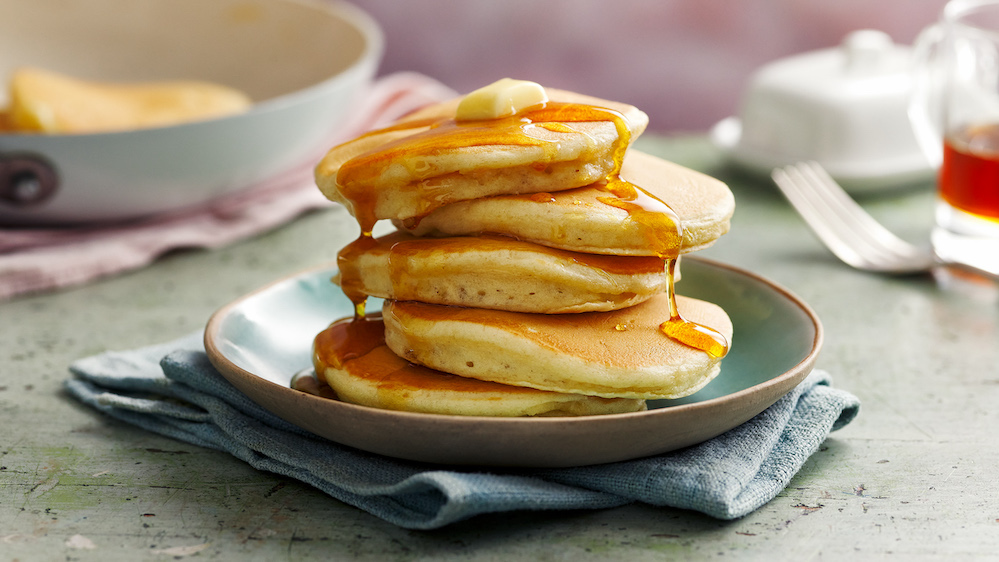There’s nothing quite like a stack of light, fluffy pancakes for breakfast. Whether topped with butter and maple syrup or fresh fruit and whipped cream, the perfect pancake is a combination of crisp edges and a tender, airy interior. While making fluffy pancakes may seem simple, achieving the ideal texture requires a few key techniques and tricks. Here’s a classic pancake recipe and tips to ensure your pancakes turn out irresistibly fluffy every time.
Classic Pancake Recipe
Ingredients:
- 1 ½ cups (190g) all-purpose flour
- 3 ½ teaspoons baking powder
- 1 tablespoon sugar
- ½ teaspoon salt
- 1 ¼ cups (300ml) milk
- 1 egg
- 3 tablespoons unsalted butter, melted
- 1 teaspoon vanilla extract (optional)
Instructions:
- Mix the dry ingredients: In a large bowl, whisk together the flour, baking powder, sugar, and salt.
- Whisk the wet ingredients: In another bowl, beat the egg and add the milk, melted butter, and vanilla extract. Whisk until smooth.
- Combine wet and dry ingredients: Slowly pour the wet ingredients into the dry ingredients and gently stir with a whisk or spatula. Mix until just combined—small lumps in the batter are fine. Overmixing can result in dense pancakes.
- Rest the batter: Let the batter rest for about 5–10 minutes. This allows the flour to hydrate and the baking powder to activate, which helps create fluffier pancakes.
- Heat the griddle or pan: Place a non-stick skillet or griddle over medium heat and lightly grease it with butter or oil.
- Cook the pancakes: Pour about ¼ cup of batter onto the hot griddle for each pancake. Cook until bubbles form on the surface and the edges look set, about 2–3 minutes. Flip the pancakes and cook for another 1–2 minutes until golden brown.
- Serve: Stack the pancakes on a plate and top with your favorite toppings like syrup, butter, fruit, or powdered sugar. Enjoy while warm!
Tips for Making Fluffier Pancakes
1. Use Fresh Baking Powder
Baking powder is the key leavening agent in pancakes, helping them rise and achieve a fluffy texture. Over time, baking powder loses its potency, so always check the expiration date. To test if your baking powder is fresh, drop a small amount into warm water—it should fizz immediately. If it doesn’t, it’s time to replace it.
2. Don’t Overmix the Batter
A common mistake in pancake-making is overmixing the batter. It’s tempting to stir until it’s perfectly smooth, but this can develop gluten in the flour, resulting in tough, dense pancakes. Instead, mix the wet and dry ingredients just until they are combined, leaving some lumps in the batter. These lumps will disappear as the pancakes cook, and they help create a tender texture.
3. Rest the Batter
Allowing your pancake batter to rest for 5–10 minutes before cooking makes a big difference. This resting period gives the baking powder time to activate and the gluten in the flour a chance to relax, leading to softer and fluffier pancakes. During this time, you’ll notice that the batter becomes slightly bubbly—this is a good sign!
4. Use Buttermilk for Extra Fluffiness
If you want to take your pancakes to the next level, swap regular milk for buttermilk. The acidity in buttermilk reacts with the baking powder (and if included, baking soda) to create extra lift, resulting in even lighter and fluffier pancakes. If you don’t have buttermilk on hand, you can make a substitute by adding 1 tablespoon of lemon juice or white vinegar to 1 cup of milk and letting it sit for a few minutes.
5. Separate the Egg Whites
For extra fluffiness, try separating the egg whites from the yolks. Beat the egg whites until soft peaks form, then gently fold them into the batter just before cooking. This technique incorporates more air into the batter, creating a lighter pancake with a cloud-like texture.
6. Use a Non-Stick Skillet or Griddle
A non-stick surface is ideal for cooking pancakes because it ensures even heat distribution and prevents sticking. Heat your pan over medium heat and allow it to warm up before adding the batter. If the pan is too cold, your pancakes may spread too much and become thin; if it’s too hot, they may burn on the outside before cooking through.
7. Cook at the Right Temperature
Maintaining the right cooking temperature is essential for fluffy pancakes. The heat should be medium or medium-low. Too high, and the pancakes will brown too quickly, leaving the inside undercooked. Too low, and they will cook slowly, becoming dry. The perfect heat allows the pancakes to puff up and develop a golden-brown exterior while remaining light and airy inside.
8. Wait for the Bubbles
One of the best indicators that your pancake is ready to flip is the appearance of bubbles on the surface. As the batter cooks, air pockets form and rise to the top, creating bubbles. When you see bubbles covering most of the surface and the edges starting to look set, it’s time to flip. Flip gently and cook for an additional 1–2 minutes on the other side.
9. Don’t Press the Pancakes
Resist the urge to press down on your pancakes with a spatula while they cook. This may seem like it speeds up the cooking process, but it actually deflates the pancakes, making them less fluffy. Let them cook undisturbed to keep their airy texture intact.
10. Use Room-Temperature Ingredients
Using room-temperature milk, eggs, and butter ensures that your pancake batter mixes more evenly, preventing lumps and cold spots. Cold ingredients can cause the butter in the batter to solidify, leading to uneven cooking and flat pancakes.
With these tips and the classic recipe, you’ll be able to create fluffy pancakes that are perfect for breakfast or brunch. Whether you keep it simple with syrup and butter or get creative with fruit, nuts, and whipped cream, mastering the art of fluffy pancakes will make your mornings all the more delicious.

